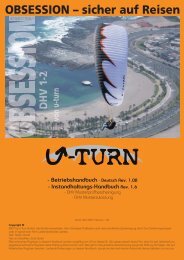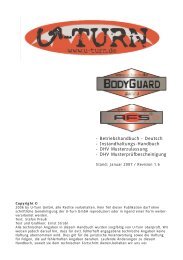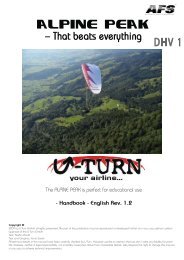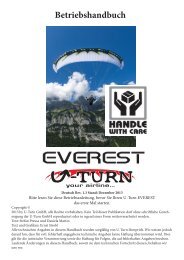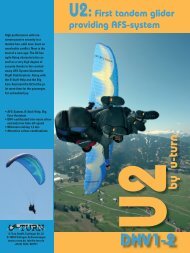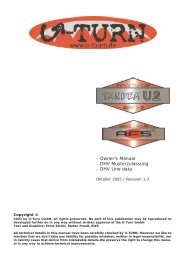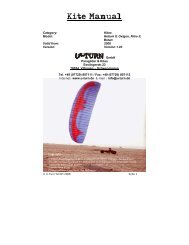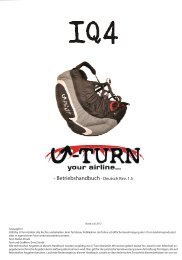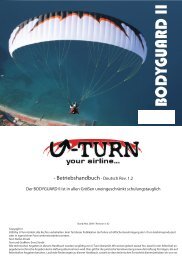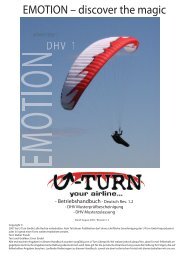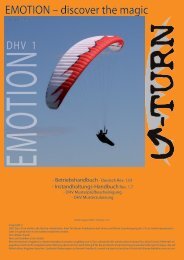Free Force 3 Manual rev 1.2.indd - U-Turn Paragliders
Free Force 3 Manual rev 1.2.indd - U-Turn Paragliders
Free Force 3 Manual rev 1.2.indd - U-Turn Paragliders
- No tags were found...
You also want an ePaper? Increase the reach of your titles
YUMPU automatically turns print PDFs into web optimized ePapers that Google loves.
- <strong>Manual</strong> - English Rev. 1.2Stand: September 2012Copyright ©2011 by U-<strong>Turn</strong> GmbH, all right preserved. No part of this publication may be reproduced or developed further on in any way without writtenapproval of the U-<strong>Turn</strong> GmbHText: Stefan PreußText and Graphics: Ernst StroblAll technical details in this manual have been carefully checked by U-<strong>Turn</strong>. However we like to mention that we don`t take any liability for possiblemistakes, neither in legal responsibility, nor in liability cases that derive from mistakable details. We preserve the right to change this manualin any way to achieve technical improvements.
You`ve got the stuff to fly!The U-<strong>Turn</strong> team would like to congratulate you on the purchase of your new U-<strong>Turn</strong> paraglider.You have made an excellent choice. We wish you long and enjoyable flights andmany happy landings with your U-<strong>Turn</strong> FREE FORCE 3.The research and Development team at U-<strong>Turn</strong> can proudly look back at many successfulyears in the flight sport industry. Our own concepts not only meet but exceed industrystandards. The combination between the latest computer based technology and theknow-how of experienced test pilots and professional competition pilots provides anexcellent basis for quality. We certainly keep our customers need in mind, and always appreciateyour input and constructive criticism. Should any questions occur, please don´thesitate to ask your U-<strong>Turn</strong> dealer or the U-<strong>Turn</strong> team.In order to provide you with the latest information on technical development and innovationsat U-<strong>Turn</strong>, we ask you to complete the questionnaire attached. Please mail it tothe following address:U-TURN GmbH<strong>Paragliders</strong> and KitesIm Neuneck 1D-78609 TuningenTel. +49 (07464) 9891280Fax: +49 (07464) 98912828Internet: www.u-turn.deE-mail: info@u-turn.deGPlease read the entire handbook carefully before using your U-<strong>Turn</strong>FREE FORCE 3 for the first time. We composed this handbook, in order tomake the handling of your new U-<strong>Turn</strong> FREE FORCE 3 as safe and easy foryou as possible.G
Business Replay Card !"#$%&'!(")*'+'#&!' ",!('(!+#&'&("+'#*''"-./"'#'"(/'&)*'
ContentsIntroduction....................................................................................................................................Page 1Gerneral Description - FREE FORCE 3................................................................................... Page 2PPN Description and Automatic flight stabilizatin (AFS)...............................................Page 3-4Linesystem and Risers................................................................................................................ Page 5-6Speed System................................................................................................................................ Page 7Suitable Harness and Rescue .................................................................................................. Page 7Operation.......................................................................................................................................Range of Operation....................................................................................................................Aerobatics......................................................................................................................................Motorised Paragliding ..............................................................................................................Page 7Page 7Page 7Page 8Preflight Check ............................................................................................................................Take off ...........................................................................................................................................<strong>Turn</strong>ing ...........................................................................................................................................Active Flying .................................................................................................................................Landing ..........................................................................................................................................Winching .......................................................................................................................................Advanced Handling................................................................................................................Wingovers........................................................................................................................................Full Frontal......................................................................................................................................Deep Stall ......................................................................................................................................Fullstall............................................................................................................................................Emergency Piloting ....................................................................................................................Negativ <strong>Turn</strong>.................................................................................................................................Collaps ............................................................................................................................................How to avoid collapses - by Ernst Strobl ............................................................................Page 8Page 8Page 9Page 9Page 9Page 9-10Page 10Page 10Page 10Page 10Page 11Page 11Page 11Page 11Page 11-12Rapid Cescent ..............................................................................................................................B-Stall...............................................................................................................................................Spiral Dive ......................................................................................................................................“Big Ears” ........................................................................................................................................Maintenance and Care .............................................................................................................Page 12Page 13Page 13Page 13Page 14Safety Advices and Liability ..................................................................................................... Page 15Nature and environment friendly behavior ...................................................................... Page 15Removal ......................................................................................................................................... Page 15Table of area loading -Materiallist FREE FORCE 3.............................................................Technical Data ..............................................................................................................................Line Code Info ..............................................................................................................................Line plan FREE FORCE 3.........................................................................................................Certification FREE FORCE 3 22..........................................................................Certification FREE FORCE 3 24..........................................................................Certification FREE FORCE 3 26..........................................................................Page16Page 17Page 18Page 19Page 20-21Page 22-23Page 24-25
ContentsInstruction leaflet for repairs and 2 annual Check............................................................Line Order Sheet .........................................................................................................................Page 26Page 27
IntroductionU-<strong>Turn</strong> paragliders are in a class of their own. U-<strong>Turn</strong> doesn`t compromise on safety, and uses the bestquality components and hallmark flight characteristics. Congratulation on your purchase of U-<strong>Turn</strong> glider,as it is the brand for those who appreciate the difference.The laws of physics are well defined. We aspire to achieve to possible within the framework of its laws.We admit this is ambitious but you will always find U-<strong>Turn</strong> at the cutting edge of technology. As OscarWilde once said in this very British understatement: “His taste is very basics; only always the best is goodenough.” The U-<strong>Turn</strong> team embodies this attitude; “We always want to deliver the best possible glider.”Nothing more and most certainly nothing less.U-<strong>Turn</strong> staff takes notice of its customers wishes, so we appreciate any comments or feedback!Please feel free to contact your competence center or U-<strong>Turn</strong> directly for any advice or direction.IMPORTANT:Having the necessary level of experience can never substitute the need to familiarizeyourself with the glider before leaving the ground. Please carefully read the handbook and take advantageof the support from your flight school, or U-<strong>Turn</strong> directly for that matter.Please always remember that aviation can be potentially dangerous and your safety is in your ownhands. We strongly encourage you to fly conservatively; this includes the judgement concerning conditionsas well as the choices you make in flight.Page 1
Gerätebeschreibung FREE FORCE 3The FREE FORCE of U-<strong>Turn</strong> is established as the perfect wing to begin acrobatic paragliding. Now thewing is upgraded: The FREE FORCE 3 got features like the Precision Profile Nose (PPN-system) which improvesthe start and flight characteristic. More than ever the FREE FORCE is the wing to enter the worldof the cool acrobatic tricks- the genes of the reference wing THRILLER are obvious in every trick.The FREE FORCE 3 got like the THRILLER compared to the in its time <strong>rev</strong>olutionary G-FORCE a reducedaspect ratio. Because of the modern and high efficiency profile this is possible without lost in dynamics.With the AFS and the PPN-system features the FREE FORCE 3 is suited for daily use on EN B level, wheremost of the ratings are even better.“The FREE FORCE 3 stands for dynamic flight fun on a high safety level. Because of the THRILLER-like manoeuvrabilityand agility combined with the safety reserves of the AFS, it is the perfect wing to all whowant to begin acrobatic paragliding” points out chief designer Ernst Strobl the rage of use. At same timethe FREE FORCE 3 got many friends in the XC pilots as well. Despite its relatively small sail, it is eager togain altitude in thermals. With a max speed of 56km/h (fully loaded) the wing is quite fast. And the AFScares with many small corrections for the maximum altitude when FREE FORCE pilots go for XC.The use of the PPN technology and the abdication of the heavy nose mylar reduce the weight of theFREE FORCE 3. This more in dynamics is clear to feel in flight. Another advantage coming from the PPNis the improved starting ability. With the PPN nothing is deforming the leading edge anymore and theFREE FORCE 3 offers consistent performance for a long lifetime.The AFS feature in a wing made for ambitious pilots- discussed after presentation of the first FREE FORCE.But the system is proven now in praxis as expected. So it is used in the FREE FORCE 3 again. The AFS inits latest version got only advantages. Dynamic figures are just easy to do and the performance reservesget in action if needed. “In dynamic manoeuvres the AFS is not active because the high internal pressurep<strong>rev</strong>ents interaction” says Strobl.On the other side in tricks like the MacTwist, when the pilot mistakes the time to break the AFS breaksautomatically and p<strong>rev</strong>ents the wing from overshooting too far in a potential dangerous level. “By thevery sporty design of the profile I could increase the sail tension in the FREE FORCE 3 significant comparedto an EN-A wing” announces Strobl. The increase of this effect is clear to notice. Anyhow the systemis not p<strong>rev</strong>enting the pilot learning the tricks: The one who is breaking correct will not notice theAFS. Naturally this is not only valid for the MacTwist, for all other tricks too.“All 44 cells of the FREE FORCE 3 are featured by the AFS”, Strobl points out. “The collapse resistance isn’tthe main issue but the p<strong>rev</strong>ention of overshooting.” Conclusion: The one who searches a wing to getinto the acrobatic flying like the pros, but wants to have a forgiving wing will find the perfect match inthe FREE FORCE 3.The total result: The use of the PPN-system together with the AFS pushes fun and dynamic. FREE FORCE3 is THE more fun and performance with the extra portion safety.Topic XC: Despite the small flat area the wing is eager in thermals. Gaining altitude is the mission of theFREE FORCE 3. Once on top the wing rewards with a minimum sink of 1,1m/s. While going for XC thewing benefits from AFS too. The system smoothes out minor turbulences by breaking automatically.This results in gaining altitude each time. In theory this is a trade off in speed, but still rests a trim of 38-39km/h and 53 to 56 km/h (full loaded) accelerated. The wing can’t hide its roots in the mega dynamicG-FORCE and THRILLER. Fly fast, high and safe! Thats the message of the FREE FORCE 3. And the onewho wants to discover the tardiness no problem for the FREE FORCE 3- the average minimum speed is23 km/h.Page 2
AFS - Automatic flight stabilizationTo fly safely means to fly actively- the system employed on the U-<strong>Turn</strong> FREE FORCE 3 allows this to happen automatically to a certainlevel. The secret of the AFS-system is based on a pre-tensioning principle. In the area of the brake attachmentpoints the undersurface is pre-tensioned. Whilst the sail is gliding through smooth air, thereis enough pressure inside and the pre-tensioning is neutralized: The e! ect of internal pressure is morepowerful than the pre-tensioning and the trailing edge stays aerodynamically perfect in the air like aconventional glider. When entering turbulent air with the FREE FORCE 3 the system adjusts immediately,even the slightest drop of internal pressure allows the system to react. The pre-tensioning at thetrailing edge is effectively like pulling the brakes.Ernst Strobl recalls the fine-tuning: “Our computer-based calcualtions were impressivel confirmed duringour tests”. The system is extremely responsive so that a top-quality manufacturing is key. U-<strong>Turn</strong> CofounderThomas Vosseler adds: “We guarantee a strongly supervised manufacturing process”. The AFSworks like the Electronic Stability Programs known in the automotive industry, you could call it an “ESPfor the air”. It intervenes for the benefit of safety when an inexperienced pilot, or a pilot in trouble, entersturbulence and is unable to fly actively. Experienced flight-instructors confirm: “This is a major step as faras safety is concerned. The main reason for accidents, the full collapse of the canopy, is minimized dramactically”.Even without AFS the U-<strong>Turn</strong> FREE FORCE 3 would be a very safe glider says Strobl. Due to theextremely pulled down wingtips and the resulting spread of the wingloading the U<strong>Turn</strong> FREE FORCE 3has far more than average resistance to collapses. The FREE FORCE 3 gliders stably ahead even after anaccelerated asymmetric collapse, a situtation that may happen after leaving a thermal, even with 50% ofthe wing area collapsed. This is unprecedented. The computer optimised wing layout leads to very goodthermal lift and maximizes the stall characteristics, both improving safety.Page 4
LinesystemIn the U-<strong>Turn</strong> FREE FORCE 3 we use 0,9/ 1,1/ 1,3 /1,6 /1,9 und 2,3mm and Technora by TAE-GU Lines Weaving Inc. andLyros Dyneema Lines, with a special waved Dyneema core. This stretch resistance p<strong>rev</strong>ents changes in flight characteristicscaused by different stretching after a short time of use. An optimum of safety and strength in proportion to drag isieved by the use of di! erent line diameters. The whole line system consists of single elememt that are sewn and loopedon both ends. All suspension and brake lines are forked in the upper cascade. The di! erent color of the lines guaranteeease of handling and control. All suspension lines are looped separately in maillons and connected to the risers.The maillons have clips built in to p<strong>rev</strong>ent slipping of the lines. The main brake line is looped through a pulley at the D-riser with a color marking where a brake toggle has to be tief off.The manufacturer settings is 0 travel plus 5 cm. Shortening more than 5 cm is not allowed and results in a “brake” conditionin flight which is extremely dangerous for takeoff , flight and landing. The factory settings provides sufficient braketravel on landing and in extreme flight conditions, as well as a comfortable arm position on trim speed.Please note that with the height of the harness mounting also the relative distance changes. When adjusting the setting,both sides have to be symmetric and a permanent knot has to be used. Optimum solution is the so called “Spierenstich”knot which doesn`t slip or affect the lines adversely.RiserThe A- and B-risers have a different colour to ensure positive identification at take off and during a B-stall descent. Thelength of all risers has been chosen in a way to get easy access to all and lineshackles in flight for special manoeuvres.Made of rigid and stretch resistant Polyster-webbing, the FREE FORCE 3 risers guarantee a long term, stabletrim.Page 5
RiserPage 6
Speed SystemThe U-<strong>Turn</strong> FREE FORCE 3 is equipped with a very effective leg-actuated speedsystem that increases the speed btw. 13and 17 km/h depending on model and pilots weight area load respectively. During extreme manoeuvers the speedsystemshould not be activated, when entering an extreme manoeuvres it should be immediately deactivated. All extrememanoeuvres (i.e. stalls...) get more dynamically at higher speed.Because the maximal adjustment of the accelerator is related to the safety characteristics of the canopy it may happen,that - using certain harnesses - the broad accelerator adjustment is not available.Suitable HarnessAll officially approved harness systems with mounting about the breast height are suitable for the FREE FORCE 3 (theyhave to be LTF and DHV rated GH). The lower the mounting, the better is the steering by shifting of the bodyweight. U-<strong>Turn</strong> recommends the new IQ4 harness for its highest level of safety and convenience. The positioning of the mountingalso changes the relative brakedistance. If you have any questions about the usage of your harness with the FREE FORCE3, ask your U-<strong>Turn</strong> dealer or directly contact U-<strong>Turn</strong>. We assist you in any possible way.Suitable Rescue SystemIt is required by law and absolutely neccessary for safe operation of your paraglider that you always carry a rescuesystem with you. When choosing a rescue system, watch out that it is approved and suitable for the intended takeoffweight. With the innovative rescue systems of the SECURE-series by U-<strong>Turn</strong> light-weight, convenient and safe reservesare available. The SECURE rescues offer extremely short opening times and low sink-rates.OperationThis instruction manual only pays attention to those points of flying technique which are important for the FREE FORCE3. It is not meant to substitute a basic flying education in an approved flying school! If a flying education and the appropriateexperience is missing, paragliding is dangerous to life.Range of OperationThe FREE FORCE 3 has been developed and tested for ordinary takeoffs, winching, and is also well suitable for motoizedoperations. An unauthorized or unapproved use of the FREE FORCE 3, or operation out of its operational limits is improperand dangerous.AerobaticsAerobatics are illegal and dangerous. There is a danger of unpredictable flight conditions that could result in overstressingboth material and pilot.Page 7
Motorised ParaglidingThe U-<strong>Turn</strong> FREE FORCE 3 is suitable due to its outstanding launching characteristics, its wide weight range and its unproblematichandling particularly well for the motorized paragliding. Please note that for the motorized use its own permissionof the combination is necessary for engineunit and glider. If you intend to operate the EMOTION 2 motorized,please contact the motor manufacturer, U-<strong>Turn</strong> and the DULV (Deutscher Ultraleichtflug Verband) for official approval.Use only approved motor / glider combinations and adhere to the regulations as well as the training requirements.Preflight CheckA careful pre flightcheck is absolutely mandatory. Double-check everything when you don´t fly yourself and make surethe person flying your FREE FORCE 3 does the same. Also ensure that the pilot flying your FREE FORCE 3, knows its operationallimits and has the required license.All lines, risers and the canopy have to be carefully checked for damage before every takeoff . Even in case of minordamages takeoff is not an option. After the glider is unpacked and layed on the ground in a halfcircle-shape, check followingitems:• Lay down the canopy to draw on the middle line before the outer lines, when pulling up the glider with the A risers,to get an easy and stable takeoff.• Set yourself up into the wind to get a symmetrical load on both sides when pulling up the canopy• The risers may not be twisted to enable smooth looping of the brakelines.• Make sure no lines are under the canopy to avoid a dangerous situation on takeoff.• Preflight all other equipment after the check of the glider carefully.Take offIt is important to evenly lay out the canopy with care. The middle of the glider is determined by the U-<strong>Turn</strong> FREE FORCE3 logo at the leading edge. It is sufficient to only hold the A-main harnesses. Being that the U-<strong>Turn</strong> FREE FORCE 3 showsno tendencies to overshoot forward it only needs to be slowed down minimally in the takeoff phase. Necessary corectionin direction using the brakes should only be performed once the canopy is above the pilot, otherwise the glidemight fall back due to excessive braking.The remaining risers should not be held during takeoff. The canopy will fill up with evenly distributed pull but altogethervery light startimpulse. Unlike other gliders it is not necessary to fill the U-<strong>Turn</strong> FREE FORCE 3 with strong inflation motionor even several fast steps. This is also true for very little wind and even zero wind. The easiest and safest way to startthe U-<strong>Turn</strong> FREE FORCE 3 is moderate inflate. Once the pilot ensures that the canopy is fully opened above him, the finaldecision for take off can be made. After several forceful steps they take off .Page 8
<strong>Turn</strong>ingThe U-<strong>Turn</strong> FREE FORCE 3 has a normal agility and reacts directly and instantly to steering inputs. You can fly flat turnswith little altitude loss by shifting of bodyweight. A combination of appropriate pull on the inner brakeline and shift ofbodyweight is the best way for a coordinated turn. The <strong>Turn</strong> radius depends on the amount of pull on the brakeline.At about 75% of brakeline travel, the FREE FORCE 3 increases bank significantly and performs a fast sleep turn that canbe continued to a diving spiral. The diving spiral has to be initiated and terminated slowly. The bank angle is controledby increasing and decreasing the pull on the inner brakeline.Warning: A rapid pull on the the brakeline may cause a spin.Active FlyingThe U-<strong>Turn</strong> FREE FORCE 3 should be flown with light braking on both sides when there is turbulent air. An increase inangle of attack provides better stability. When entering heavy thermals or strong turbulences be mindful of that thecanopy does not get behind the pilot. To avoid that, release the brakes a bit to get an increase in speed when enteringthe updraft.If the canopy gets in front of the pilot when leaving a updraft or entering a downdraft the brakes have to be applied tocounter that. Accelerated flight however is advisable when flying through a downdraft zone. The FREE FORCE 3 is verystable overall, never the less is active flying a big flight safety factor. Collapsing and deforming of the canopy can beavoided by active flying (as above mentioned) in turbulent air.LandingStart your landing preperation at sufficient altiude. Due to its excellent flaring characteristics, the FREE FORCE 3 is veryeasy to land. Glider in fairly normal to a straight- in final against the wind and get up in the harness early enough. Accordingto the wind, the brakes have to be pulled firmly and dynamically, about one meter above ground, beyond thestalling point. If there is a strong headwind, be careful with the amount of braking. Don`t perform landings out of steepturns and big directional changes short prior landing, to avoid PLF.Warning: During a strong wind takeoff attempt, ground handling and landing tha leadingwdge can hit the ground withhigh speed. Avoid this! Otherwise the ribs, the sewings or the fabric can be damaged.WinchingBecause of its excellent starting characteristics, the U-<strong>Turn</strong> FREE FORCE 3 is well suitable for winching operations.Take the following points into account:• maximum linetension for winching is 100kp.• if not operating at your usual winch, get acquainted with the local procedures and get a good briefing by a localpilot.• bodyposition and pulling up the canopy does not di! er from a normal takeoff . The canopy has to becompletely over the pilot at takeoff . No early steering inputs to avoid falling back of the canopy or beingpulled off with a non flyable glider. Never give the takeoff -command before you have total controlover your glider. Don´t turn too much during the takeoff -phase and before reaching the minimum safealtitude.Page 9
• never winch the FREE FORCE 3 with loads outside the allowable weight range• all involved persons, machines and accessories have to have the appropriate licenses, approvals, certifications forwinching.Advanced HandlingEven with its high stability and good flight characteristics it is possible that the FREE FORCE 3 gets into an extreme flightcondition due to pilot mistakes or turbulent air. To be prepared for such situations and able to handle them in a calmand superior manner it is best to take part in a flight safety course.Advanced manoeuvers may only be flown at sufficient altitude, in calm air and with professional supervision (i.e. duringa safety course). Once again we mention that a rescuesystem is required by the law.The following extreme manoeuvers can be either caused intentionally, by pilots mistakes or by bad weather conditions.Every pilot can get in such a situation! All mentioned extreme manoeuvers are dangerous if they are performed withoutthe appropriate knowledge or enough altitude or the necessary introduction. A wrong execution of these manoeuvresmay have fatal consequences!WingoversThe pilot has to perform right and left turns with increasing bank until the desired angle is reached. Appropriate breakpressure during up or down swing will p<strong>rev</strong>ent the wing tips from folding. Collapsing is only a factor.Full FrontalA negative AoA caused by turbulences or the simultaneous pulldown of the A-risers by the pilot, results in a frontal collapseof the leading edge. The FREE FORCE 3 normally comes out of a frontstall by itself very quickly. Smooth and symmetricapplying of the brakes assists the opening of the canopy positively.Deep StallThe FREE FORCE 3 is not stall sensitive. If in a stall, caused by overpulling on the brakes, the rear risers or a delayed B-stallexit, the release of the brakes or the rear risers, recovers the stall. Should the stall be caused by an extreme flight conditionor configuration ( i.e. takeoff weight to low), a symmetric forward push on the A-risers or step the speed systemrecovers the stall.Warning: Practicing stalls should be done with enough safe altitude. Never apply asymmetric brakes during a stall, itcould cause a spin.Page 10
FullstallTo enter a fullstall pull both brakes full travel (ensure no twisted or wrapped lines). The canopy has to be stabilized beforerecovering the fullstall. Rise both brakes slowly and symmetrically to recover. If done right, the canopy overshootsa little forward without collapsing. Avoid an asymmetric recovery by all means. The dynamic forces drive the canopy tooverreact and a collapse could occur.Warning: Never release the brakes at the beginning of the recovery when the canopy tilts forward, thecanopy may accelerate foward in a way that makes contact or even falling into the canopy possible.The fullstall is a dangerous manoeuver and should not be performed intentionally except during a flightsafety course.Emergency PilotingIn any situation where normal steering with the brakelines is not possible, the FREE FORCE 3 can be steered with theback risers easily.Negativ <strong>Turn</strong>To enter a spin the pilot has to fully and quickly pull one of the brakelines when he is near the stallpoint. The glider rotatesfast around its center while the inner wingtip flies backwards. For recovery just release the applied brake to let theglider accelerate.Warning: The spin is a dangerous manoeuvres and should not be performed intentionally except during a flight safetycourse.CollapsesEven with its high stability and very responds well in turbulence, strong turbulences can cause the FREE FORCE 3 to collapse.That situation is not really dangerous and clears itself automatically, without any further input required. To supportthe recovery, firmly apply brakes on the affected side and simultaneously steer opposite on the open side. Whena large part of the canopy is collapsed be careful and smooth when applying opposite steering to avoid a completedisruption of airflow and entering a fullstall.How to avoid collapsesSingle side collapses close to the ground are the number one reason for accidents with paragliders. To avoid them, orhow to handle the situation when it happened, some tips and tricks from U-<strong>Turn</strong> test- and competition pilot Ernst Strobl:The best way to avoid collapses upfront is the right choice of the paraglider. A lot of pilots fly a glider that is a little toohot to handle for them. So why don`t you get a glider with a lower rating but in the end fly better and higher in theupdrafts and have a lot more fun and by the way be safer, too. To optimize the feeling for your glider on the ground, trythe following:Practise on the ground with the right wind at a suitable location. Slowly pull up the canopy and try to hold it up as longas possible without looking towards it. That is a good way to improve the feeling for your glider and is a prerequisitefor „active flying“ (the key to avoid collapses). Very important is also a close look at the terrain. Watch for obstacles thatcould cause turbulences ( buildings, trees, ...). On certain days, for example a freshly mowed madow as landing field,could cause a lot of thermal activity.Page 11
Fly very alert on a thermal active day. Watch your canopy, collapses most of the time, announce themself.Light braking in turbulences mostly avoids a collapse. You should have already practised that on the ground.Should a collapse occur close to the ground don´t always try to p<strong>rev</strong>ent a turn away.There is a danger when the braking on the open side is to strong, to lose the airflow on this side andstall the glider. Rather use the turn away motion to try to open the collapsed side.Apply smooth braking on the open side, depending on the size of the collapse, and maybe a little pumpingaction. Some canopies open a lot better when the brakes are fully applied once on the according side, butthat depends on the brakeline adjustment and your armlength. Wrapped lines are cleared by braking the oppositeside at enough altitude and pumping the affected side a couple of times. Watch out for a possible stall.If that does not clear the situation, try to pull down the outer line as much as possible. If you are too low forthat, stabilize the canopy on the opposite side to avoid turning away, and leave the lines like they are. Insteadof any -risky manoeuvers rather concentrate on the landing. In the end one more advice in order to have allkinds of situations under control.Visit a safety-training above water. There is no better way to practice the right behaviour than simulating adangerous situation. Don’t get caught off guard by your first collapse. In addition, during safety-training youcan familiarize yourself with the particulars of your equipment and you gain confidence in your glider as wellas your own abilities.Thus far the expert advise concerning collapses,by Ernst StroblRapid DescentIn any situation where you have to get down ASAP for different reasons (weather, extreme updraft, or other dangers,)there are a couple of techniques that are described in this chapter.Warning: The described manoeuvres stress you paraglider more than normal and should only be performed for practiseor in a real emergency!Page 12
B-StallAnother very efficient descent method is the B-Stall. It allows for a rate of descent of 6 to over 9 meters per second.Check the airspace under and behind you prior to initiating a B-Stall. To initiate it you hold the two B-risersabove the lines carabiner. While you hold the brakes in your hands at all times, pull them down progressively andsymmetrically. Hold this position. Your sail will stop flying forward, partially empty, and stabilize itself above yourhead. Exit B-stall flight by returning the risers symmetrically into their original position.We recommend not to simply let the risers snap shut as this puts a lot of pressure on the material. In the paragraphtitled “advanced handling” you can read what to do if you get caught unexpectedly in a stall.Spiral DiveLike a normal turn, it is very easy to get the FREE FORCE 3 into a spiral dive. The spiral dive gets you a descent rate up to20 m/s. To prepare oneself in case of, practise it in optimum conditions. The diving spiral gets the pilot down faster thanother techniques and is therefore best suited for an emergency descent. They move down vertically within the airmass.Don`t forget the G-forces when diving down, and take that into consideration before initiating a rapid descent.WARNING: If initiation is too fast there is a danger of a spin, in this case release the brake an try a smoother initiation.WARNING: Never fly a spiral dive while “big earing” the glider. It is illegal aerobatics and may over stress the both pilotand material.Big EarsPull both on the outer A-risers one after the other (grab the line shackles) about 15-20cm to fold the wingtips. Whilstholding the braketoggles together with the A-risers. The glider stays fully steerable and descents with 4-7m/s straightforward. If you release the A-risers, the folded wingtips open automatically. Should there be any problem with the reopening,you may pump the brakes gently. „Big earing“ is due to the high wingload a very stable flight condition and wellsuited for turbulent air.Be aware that you reduce the trimspeed, but that can be compensated by accelerating with your legs.WARNING: Don`t fly extreme manoeuvres in this configuration, it is dangerous due to the danger of overstressing yourglider. Fullstalls and spins are dangerous for a rapid descent because a wrong termination could have fatal consequencesno matter what glidertype you are flying.ALL KINDS OF RAPID DESCENTS SHOULD BE PRACTISED IN SMOOTH AIR AND WITH ENOUGH ALTITUDETO BE PREPARED FOR EXTREME SITUATIONS WHEN YOU NEED THEM!GPage 13
Maintenace and CareBecause U-<strong>Turn</strong> only uses high quality materials, your FREE FORCE 3 will be airworthy for many years if you take goodcare. The aging of your FREE FORCE 3 depends on the total flying time, the conditions you fly in, the amount of UV radiationit is exposed to and the intensity and quality of care. A couple of tips for maintenance and care:Long lasting exposure to UV radiation and normal use stress the material.• Don’t expose your glider to the sun when there is no need to.• Consider the choice of terrain where you lay out the glider for takeo! .• Assymmetrical and changing folding patterns prolong the lifetime of the material especially in the middle section.Please take following points into consideration:• regular checks for damage• no unneccessary bending• lines after overloads (tree landings, water landings, etc.) for its strength and correct length to be checked and exchangedif necessary.• in case of changing in flight handling characteristics, the lines have to be checked for their correct length• don’t tie the brakelines on the grips if not needed, it weakens the linesTo clean the canopy use warm water and a soft sponge.If you use a detergent for hard stains, make sure that you rinse intensively afterwards. Never apply anychemicals for cleaning, they weaken the material and damage the coating. Store your glider at a dry anddark location away from any chemicals. After two years or 300 flighthours, whichever occurs first, your FREEFORCE 3 has to be inspected by the manufacturer, in case of extreme use we are glad to do that earlier. Onlyyou know about the condition of your glider. Should there be a need for any repairs they are to be done bythe manufacturer.GU-<strong>Turn</strong> cannot be hold responsible for any 2-year inspection and any repairsnot performed by U-<strong>Turn</strong> or an U-<strong>Turn</strong> authorized dealer. Any checking orrepairing performed by people not authorized by U-<strong>Turn</strong> will cause denial ofany warranty!GPage 14
GSafety Advices and LiabilityThis glider complies with EAPR, AFNOR (SHV and ACPUL) regulations, for the tested type, at time of delivery(see appendix).The operation of the glider is at your own risk. The manufacturer and the dealer don´t take any liabilityfor accidents and follow on damages. Please consider all safety notes, cautions and warnings for safeflying. Further, we assume that the pilot has the necessary certifications and that the legal limitations arebeing followed. Use of the equipment is at your own risk. Follow the safety instructions for a safe flight.Special emphasis on following points:• stick to the rules and regs of the country you fly in• required licenses and actual experience• use only suitable, approved and certi$ ed accessories (helmet, harness, safety systems...)• appropriate weather condition• suitable terrain• all required checks done and airworthiness of the glider• personal shape of the pilot• know your manual and stay within the published limitsNature and environment friendly behaviourWe ask you to perform our sport in a manner, that impacts nature and environment with minimumintensity. Please do not walk beside marked paths, don´t leave any waste, please be not noisy andrespect the sensitive biological equilibrium in the mountains. Especially at starting areas maximum carefor nature is necessary.RemovalThe synthetic materials your U-<strong>Turn</strong> glider is build must be depolluted appropriately. Please send yourU-<strong>Turn</strong> glider at the end of its life-cycle back to U-<strong>Turn</strong>. We will take care for recycling and removal.Page 15
Table of area loading - Materiallist FREE FORCE 33Flächenbelastungstabelle / Table of area loadingStartgewicht / Take off weight (kg) 50 55 60 65 70 75 80 85 90 95 100 105 110 115 120 125 130<strong>Free</strong> <strong>Force</strong>3 22 2,2 2,4 2,7 2,9 3,1 3,3 3,6 3,8 4,0 4,2 4,4 4,7 4,9 5,1 5,3<strong>Free</strong> <strong>Force</strong>3 24 2,4 2,7 2,9 3,1 3,3 3,5 3,7 3,9 4,1 4,3 4,5 4,7 4,9 5,1<strong>Free</strong> <strong>Force</strong>3 26 2,6 2,8 3,0 3,2 3,4 3,6 3,8 4,0 4,2 4,3 4,5 4,7 4,93MateriallisteBezeichnung der Verwendung Herstellerbezeichnung technische Maße / Dimension Lieferant / DIN Nr.im Gesamtsystem Gewicht / FestigkeitAufhängungsschlaufen Nylon 7,2 g/m / Bruchlast 110kg / 13mm Breite Kolon Industrial Co. KoreaBeschleunigerleine Nylon Ø 4,0mm = Bruchlast 350 daNBeschleuniger- Bremsrolle GIN Rolle Gin Gliders KoreaBeschleunigerschloß Brummelhook Gin Gliders KoreaBremsaufhängungen Nylon 7,2 g/m / Bruchlast 110kg / 13mm Breite Kolon Industrial Co. KoreaBremsgriff High Tanacity Poliester Yarn 22mm 25 g/m / 1000 kg Bruchlast Techni Sangles, FranceBremsgriffaufhängung High Tanacity Poliester Yarn 22mm 25 g/m / 1000 kg Bruchlast Techni Sangles, FranceBremsgriffbefestigung Magnet Gin Gliders KoreaBremsstammleine 2,3mm Ø TSL 380 2,3mm =260daN LirosLeinen, DSL70, Liros lines Rosenberger TauwerkeTSL 140, 190, 220 ,280, 380 GermanyGurtumlenkungen Stainless Steel 8g / Ø 3,8mm / Bruchlast 800kg Ansung Precision CO. KoreaLeinenschlösser Stainless Steel 12g / Ø 4,3mm / Bruchlast 1000kg Ansung Precision CO. KoreaObersegel Vorne / hinten 9017 E77A / DOKDO-30DMF 40 g/m² - 40 g/m² - 40 g/m² (PA 6.6 HT) Porcher Marine, NCV, FranceV-Tape RS3 40 g/m² (PA 6.6 HT) Paratex, GermanyProfilnase Verstärkung P 260 283 g/m² Dimension-Polyant, GermanyRippen, Profile RS3 40 g/m² (PA 6.6 HT) Paratex, GermanyTragegurt High Tanacity Poliester Yarn 22mm 25 g/m / 1000 kg Bruchlast Techni Sangles, FranceUntersegel DOKDO-30DFM 40 g/m² (PA 6.6 HT) Porcher Marine, NCV, FranceVerstärkung Anlenklunkte B/C/D W 420 180 g/m² Porcher Marine, NCV, FranceNähfaden Kappe High Tanacity Poliester Yarn 150D/2 0,05 g/m² / 2,9 kg Bruchlast Amann & Söhne GmbH, GermanyNähfaden Leinen High Tanacity Poliester Yarn 150D/3 0,083 g/m² / 3,2 kg Bruchlast Amann & Söhne GmbH, GermanySeite Page 16 22
Technical Data22 24 26Take of weight 55 - 95 kg 70 - 105 KG 85 - 125 kgWing area flat 24 m² 26,5 m² 29 m²Wing area project 22,5 m² 24,5 m² 26,5 m²Wing span flat 11,28 m 11,86 m 12,4 mWing span project 9,8 m 10,2 m 10,6 mAspect ratio flat 5,3 5,3 5,3Aspect ratio flat project 4,2 4,2 4,2Number of chambers 44 44 44V-Trimm 39-40 Km/h 39-40 Km/h 39-40 Km/hV-Min 22-25 Km/h 22-25 Km/h 22-25 Km/hV-Max ~53-56 Km/h ~53-56 Km/h ~53-56 Km/hFeatures AFS, V-Tapes, PPN,Tension StripesAFS, V-Tapes, PPNTension StripesAFS, V-Tapes, PPN,Tension StripesA-Riser A-Riser A-RiserNumber of risers 5 5 5Number of line storeys 2 2 2Accelerator / Trimmer Accelerator Accelerator AcceleratorGlider weight 5,8 kg 6,1 kg 6,4 kgCertification LTF C LTF C LTF CYou will find further details regarding the construction and measurement of the U-<strong>Turn</strong> FREE FORCE 3 in the “Typenkennblatt”or, in case of equipment with example registration, in the “Luftsportgerätekennblatt” in acoordance with paragraph four of the“Luftverkehrszulassung”. (See attachements)You can find possible technical changes in the attachement to this manual.Important: any self inflicted changes to the construction that go beyond the allowed adjustment options, void the operating licenseand are potentially life threatening. Use of this paraglider is at your own risk. The producer and distributor cannot be held liable.Seite 23 Page 17
Linecode InfoPage 18S1S2S3SA3ST1BSB3SC3AT5AT7AT9AT11AT13AT15AT17AT19AT21BT5BT7BT9BT11BT13BT15BT17BT19BT21CT5CT7CT9CT11CT13CT15CT17CT19CT21DT5DT7DT9DT11DT13DT15DT17DT19DT21A1A2A3B3C3D3B2C2D2B1C1D1BRM1BR1-3BR1-2 BR1-1BR1BR3BR5BR7BR9BR11BR13BR15BR17BR19BR213
Lineplan FREE FORCE 3 <strong>Free</strong> <strong>Force</strong> 3 22 <strong>rev</strong>4 05.10.11A-LeinenCheck Lenght <strong>Free</strong> <strong>Force</strong> 3 24 <strong>rev</strong>4 05.10.11Check Lenght <strong>Free</strong> <strong>Force</strong> 3 26 <strong>rev</strong>4 05.10.11Check LenghtFinal EAPR A-LeinenFinal EAPR A-LeinenFinal EAPR<strong>Free</strong> <strong>Force</strong> 3 lineconfig. 05.10.2011A-LeinenAT21 2629 4250 A3 6859 AT21 2814 4545 A3 7345 AT21 2890 4670 A3 7550 AT9 TSL 190 TSL 380AT19 2547 6774 AT19 2727 7259 AT19 2800 7460 AT8 TSL 190AT17 2565 6791 AT17 2746 7278 AT17 2820 7480 AT7 TSL 190AT15 2447 4340 A2 6768 AT15 2620 4645 A2 7253 AT15 2690 4770 A2 7450 AT6 TSL 140 TSL 280AT13 2365 6688 AT13 2532 7168 AT13 2600 7360 AT5 TSL 140AT11 2374 6696 AT11 2542 7177 AT11 2610 7370 AT4 TSL 140AT9 2001 4685 A1 6677 AT9 2142 5015 A1 7156 AT9 2200 5150 A1 7354 AT3 DSL 70 TSL 220AT7 1910 6587 AT7 2045 7059 AT7 2100 7254 AT2 DSL 70AT5 1838 6513 AT5 1967 6977 AT5 2020 7174 AT1 DSL 70SA3 1301 6427 SA3 1393 6875 SA3 1430 7069 SA1 DSL 70S1 919 6045 S1 984 6464 S1 1010 6648 S1 DSL 70B-LeinenBT21 2634 4200 B3 6818 BT21 2819 4500 B3 7306 BT21 2895 4620 B3 7505 BT9 TSL 190 TSL 380BT19 2547 6734 BT19 2727 7215 BT19 2800 7410 BT8 TSL 190BT17 2565 6743 BT17 2746 7234 BT17 2820 7430 BT7 TSL 190BT15 2438 4295 B2 6719 BT15 2610 4595 B2 7194 BT15 2680 4720 B2 7390 BT6 TSL 140 TSL 280BT13 2365 6646 BT13 2532 7115 BT13 2600 7310 BT5 TSL 140BT11 2379 6658 BT11 2546 7131 BT11 2615 7325 BT4 TSL 140BT9 1992 4645 B1 6633 BT9 2133 4975 B1 7106 BT9 2190 5110 B1 7298 BT3 DSL 70 TSL 220BT7 1910 6546 BT7 2045 7018 BT7 2100 7206 BT2 DSL 70BT5 1838 6474 BT5 1967 6937 BT5 2020 7129 BT1 DSL 70SB3 1219 6347 SB3 1305 6792 SB3 1340 6980 SB1 DSL 70S2 910 5131 ST1B 6036 S2 974 5490 ST1B 6461 S2 1000 5640 ST1B 6639 S2 DSL 70 TSL 190C-LeinenCT21 2629 4210 C3 6823 CT21 2814 4520 C3 7321 CT21 2890 4640 C3 7522 CT9 TSL 140 TSL 280CT19 2547 6740 CT19 2727 7234 CT19 2800 7432 CT8 TSL 140CT17 2570 6764 CT17 2751 7255 CT17 2825 7457 CT7 TSL 140CT15 2433 4320 C2 6750 CT15 2605 4635 C2 7231 CT15 2675 4760 C2 7440 CT6 DSL 70 TSL 220CT13 2365 6682 CT13 2532 7158 CT13 2600 7365 CT5 DSL 70CT11 2383 6699 CT11 2551 7177 CT11 2620 7385 CT4 DSL 70CT9 1988 4685 C1 6669 CT9 2128 5025 C1 7145 CT9 2185 5160 C1 7344 CT3 DSL 70 TSL 190CT7 1910 6586 CT7 2045 7062 CT7 2100 7256 CT2 DSL 70CT5 1838 6515 CT5 1967 6983 CT5 2020 7179 CT1 DSL 70SC3 1210 6335 SC3 1295 6780 SC3 1330 6970 SC1 DSL 70S3 955 6079 S3 1022 6510 S3 1050 6686 S3 DSL 70D-LeinenDT21 2456 4540 D3 6987 DT21 2629 4855 D3 7479 DT21 2700 4985 D3 7687 DT9 DSL 70 TSL 220DT19 2365 6899 DT19 2532 7386 DT19 2600 7586 DT8 DSL 70DT17 2393 6926 DT17 2561 7414 DT17 2630 7616 DT7 DSL 70DT15 2265 4615 D2 6875 DT15 2425 4935 D2 7359 DT15 2490 5070 D2 7564 DT6 DSL 70 TSL 220DT13 2183 6792 DT13 2337 7269 DT13 2400 7474 DT5 DSL 70DT11 2202 6812 DT11 2357 7287 DT11 2420 7494 DT4 DSL 70DT9 1824 4940 D1 6759 DT9 1952 5290 D1 7239 DT9 2005 5430 D1 7439 DT3 DSL 70 TSL 190DT7 1728 6658 DT7 1850 7135 DT7 1900 7332 DT2 DSL 70DT5 1647 6577 DT5 1763 7050 DT5 1810 7242 DT1 DSL 70BremsleinenB-LeinenC-LeinenD-LeinenBremsleinenBR21 2884 3225 BR1-1 1450 7543 BR21 3087 3450 BR1-1 1630 8162 BR21 3170 3545 BR1-1 1680 8388 BR11 DSL 70 TSL 140 TSL 380BR19 2661 (+300) 7326 BR19 2848 (+300) 7924 BR19 2925 (+300) 8147 BR10 DSL 70BR17 2524 7190 BR17 2702 7776 BR17 2775 7997 BR9 DSL 70BR15 2675 3010 BR1-2 7127 BR15 2863 3225 BR1-2 7713 BR15 2940 3310 BR1-2 7923 BR8 DSL 70 TSL 140BR13 2534 6984 BR13 2712 7560 BR13 2785 7768 BR7 DSL 70BR11 2470 6917 BR11 2644 7494 BR11 2715 7698 BR6 DSL 70BR9 2515 7001 BR9 2693 7580 BR9 2765 7785 BR5 DSL 70BR7 2024 3420 BR1-3 6920 BR7 2167 3660 BR1-3 7487 BR7 2225 3760 BR1-3 7697 BR4 DSL 70 TSL 140BR5 1947 6843 BR5 2084 7404 BR5 2140 7612 BR3 DSL 70BR3 1851 6747 BR3 1982 7302 BR3 2035 7505 BR2 DSL 70BR1 1751 6646 BR1 1875 7195 BR1 1925 7397 BR1 DSL 70B-LeinenC-LeinenD-LeinenBremsleinenB-LeinenC-LeinenD-LeinenBremsleinenPage 19
Certification FREE FORCE 3 22Erklärung über Bauausführung und Leistung (EBL)Declaration of Design and Performance (DDP)02.10.2011Gleitsegel - ParagliderEBL-GS-DB - Stand 01.11.2010 - V4Musterprüfung / Type testingGerätemuster / Test sampleEAPR-GS-7466/<strong>Free</strong> <strong>Force</strong> 3-22Musterprüfinhaber / Type Testing HolderDatum der Musterprüfbescheinigung / Date of type testingcertificationArt der Prüfung / Type of testingBezug / referenceNachgewiesene Normen und VerfahrenCertified standards and proceduresGerätegewicht ohne Packsack / System weight without bag - kgZulässiges min. Anhängelast / Allowable min. payloadZulässiges max. Anhängelast / Allowable max. payloadAnzahl der Sitze / Number of seatsKlassifizierung / ClassificationFußbeschleuniger / Foot acceleraterTrimmer ( von Hand zu bedienen) / Trim device (hand operated)Schulungstauglich (Herstellerangabe) / suitable for trainingU-<strong>Turn</strong> GmbHEsslinger Straße 2378609 TuningenDeutschlandvereinfacht7419LTF 91/09EN 926-1 & 926-26,1 kg60 kg1Cja / yesnein / noNein / no95 kgTragegurtlängen mm/ Riser lenght mmOffen-normal / open-normalBeschleunigt / AcceleratedGeschlossen / closedA5603800A25603800B5604000C5604800D5605600E000Erklärung über Bauausführung und Leistung (EBL) EAPR-GS-7466/ 02.10.2011S1/2Page 20
Certification FREE FORCE 3 22Erklärung über Bauausführung und Leistung (EBL)Declaration of Design and Performance (DDP)02.10.2011Gleitsegel - ParagliderEBL-GS-DB - Stand 01.11.2010 - V4Musterprüfung / Type testingGerätemuster / Test sampleEAPR-GS-7466/<strong>Free</strong> <strong>Force</strong> 3-22Musterprüfinhaber / Type Testing HolderDatum der Musterprüfbescheinigung / Date of type testingcertificationArt der Prüfung / Type of testingBezug / referenceNachgewiesene Normen und VerfahrenCertified standards and proceduresGerätegewicht ohne Packsack / System weight without bag - kgZulässiges min. Anhängelast / Allowable min. payloadZulässiges max. Anhängelast / Allowable max. payloadAnzahl der Sitze / Number of seatsKlassifizierung / ClassificationFußbeschleuniger / Foot acceleraterTrimmer ( von Hand zu bedienen) / Trim device (hand operated)Schulungstauglich (Herstellerangabe) / suitable for trainingU-<strong>Turn</strong> GmbHEsslinger Straße 2378609 TuningenDeutschlandvereinfacht7419LTF 91/09EN 926-1 & 926-26,1 kg60 kg1Cja / yesnein / noNein / no95 kgTragegurtlängen mm/ Riser lenght mmOffen-normal / open-normalBeschleunigt / AcceleratedGeschlossen / closedA5603800A25603800B5604000C5604800D5605600E000Page 21
Certification FREE FORCE 3 24Erklärung über Bauausführung und Leistung (EBL)Declaration of Design and Performance (DDP)02.10.2011Gleitsegel - ParagliderEBL-GS-DB - Stand 01.11.2010 - V4Musterprüfung / Type testingGerätemuster / Test sampleEAPR-GS-7419/-<strong>Free</strong> <strong>Force</strong> 3-24Musterprüfinhaber / Type Testing HolderDatum der Musterprüfbescheinigung / Date of type testingcertificationArt der Prüfung / Type of testingBezug / referenceNachgewiesene Normen und VerfahrenCertified standards and proceduresGerätegewicht ohne Packsack / System weight without bag - kgZulässiges min. Anhängelast / Allowable min. payloadZulässiges max. Anhängelast / Allowable max. payloadAnzahl der Sitze / Number of seatsKlassifizierung / ClassificationFußbeschleuniger / Foot acceleraterTrimmer ( von Hand zu bedienen) / Trim device (hand operated)Schulungstauglich (Herstellerangabe) / suitable for trainingU-<strong>Turn</strong> GmbHEsslinger Straße 2378609 TuningenDeutschlandumfassendLTF 91/09EN 926-1 & 926-25,8 kg70 kg1Cja / yesnein / noNein / no105 kgTragegurtlängen mm/ Riser lenght mmOffen-normal / open-normalBeschleunigt / AcceleratedGeschlossen / closedA5603800A25603800B5604000C5604800D5605600E000Erklärung über Bauausführung und Leistung (EBL) EAPR-GS-7419/- 02.10.2011S1/2Page 22
Certification FREE FORCE 3 24Erklärung über Bauausführung und Leistung (EBL)Declaration of Design and Performance (DDP)02.10.2011Gleitsegel - ParagliderEBL-GS-DB - Stand 01.11.2010 - V4Musterprüfung / Type testingGerätemuster / Test sampleEAPR-GS-7419/-<strong>Free</strong> <strong>Force</strong> 3-24Musterprüfinhaber / Type Testing HolderDatum der Musterprüfbescheinigung / Date of type testingcertificationArt der Prüfung / Type of testingBezug / referenceNachgewiesene Normen und VerfahrenCertified standards and proceduresGerätegewicht ohne Packsack / System weight without bag - kgZulässiges min. Anhängelast / Allowable min. payloadZulässiges max. Anhängelast / Allowable max. payloadAnzahl der Sitze / Number of seatsKlassifizierung / ClassificationFußbeschleuniger / Foot acceleraterTrimmer ( von Hand zu bedienen) / Trim device (hand operated)Schulungstauglich (Herstellerangabe) / suitable for trainingU-<strong>Turn</strong> GmbHEsslinger Straße 2378609 TuningenDeutschlandumfassendLTF 91/09EN 926-1 & 926-25,8 kg70 kg1Cja / yesnein / noNein / no105 kgTragegurtlängen mm/ Riser lenght mmOffen-normal / open-normalBeschleunigt / AcceleratedGeschlossen / closedA5603800A25603800B5604000C5604800D5605600E000Page 23
Certification FREE FORCE 3 26Erklärung über Bauausführung und Leistung (EBL)Declaration of Design and Performance (DDP)02.10.2011Gleitsegel - ParagliderEBL-GS-DB - Stand 01.11.2010 - V4Musterprüfung / Type testingGerätemuster / Test sampleEAPR-GS-7465/<strong>Free</strong> <strong>Force</strong> 3-26Musterprüfinhaber / Type Testing HolderDatum der Musterprüfbescheinigung / Date of type testingcertificationArt der Prüfung / Type of testingBezug / referenceNachgewiesene Normen und VerfahrenCertified standards and proceduresGerätegewicht ohne Packsack / System weight without bag - kgZulässiges min. Anhängelast / Allowable min. payloadZulässiges max. Anhängelast / Allowable max. payloadAnzahl der Sitze / Number of seatsKlassifizierung / ClassificationFußbeschleuniger / Foot acceleraterTrimmer ( von Hand zu bedienen) / Trim device (hand operated)Schulungstauglich (Herstellerangabe) / suitable for trainingU-<strong>Turn</strong> GmbHEsslinger Straße 2378609 TuningenDeutschlandvereinfacht7419LTF 91/09EN 926-1 & 926-26,8 kg85 kg1Cja / yesnein / noNein / no125 kgTragegurtlängen mm/ Riser lenght mmOffen-normal / open-normalBeschleunigt / AcceleratedGeschlossen / closedA5603800A25603800B5604000C5604800D5605600E000Erklärung über Bauausführung und Leistung (EBL) EAPR-GS-7465/ 02.10.2011S1/2Page 24
Certification FREE FORCE 3 26Erklärung über Bauausführung und Leistung (EBL)Declaration of Design and Performance (DDP)02.10.2011Gleitsegel - ParagliderEBL-GS-DB - Stand 01.11.2010 - V4Musterprüfung / Type testingGerätemuster / Test sampleEAPR-GS-7465/<strong>Free</strong> <strong>Force</strong> 3-26Musterprüfinhaber / Type Testing HolderDatum der Musterprüfbescheinigung / Date of type testingcertificationArt der Prüfung / Type of testingBezug / referenceNachgewiesene Normen und VerfahrenCertified standards and proceduresGerätegewicht ohne Packsack / System weight without bag - kgZulässiges min. Anhängelast / Allowable min. payloadZulässiges max. Anhängelast / Allowable max. payloadAnzahl der Sitze / Number of seatsKlassifizierung / ClassificationFußbeschleuniger / Foot acceleraterTrimmer ( von Hand zu bedienen) / Trim device (hand operated)Schulungstauglich (Herstellerangabe) / suitable for trainingU-<strong>Turn</strong> GmbHEsslinger Straße 2378609 TuningenDeutschlandvereinfacht7419LTF 91/09EN 926-1 & 926-26,8 kg85 kg1Cja / yesnein / noNein / no125 kgTragegurtlängen mm/ Riser lenght mmOffen-normal / open-normalBeschleunigt / AcceleratedGeschlossen / closedA5603800A25603800B5604000C5604800D5605600E000Page 25
"$" -*%%."*!"#%&&'"(&('(')"%)"%"*"*""""+,+,),' /0"1"" *&$)"*+''2" ' &%'&% ""+, .+,3%& &,&%& -) "&$, 4)"'(&, "**" " 4"5&,% ,& '(&,)"" *1"%6)&*&,)"*%&&&)"&,&')%""*''&&' %"3Page 26
Leinen-BestellformularU-<strong>Turn</strong> GmbH Tel: +49 (0)7464/9891280Im Neuneck 1 Fax: +49 (0)7464/989128-2878609 TuningenGermanyLINE ORDER SHEET / BESTELLFORMULAR FÜR LEINENNameAdress / AdresseE-mailTelephone Number /Telefon NummerParagliding name /Gleitschirm NameSize / GrößeOther / SonstigesSerial Number / Serien Nummer: _ _ _ _ ____ _ _ - _ _ _ _ - _ _ _ _Line ID /BezeichnungQuantity/StückzahlLine ID /BezeichnungQuantity/StückzahlPage 27



